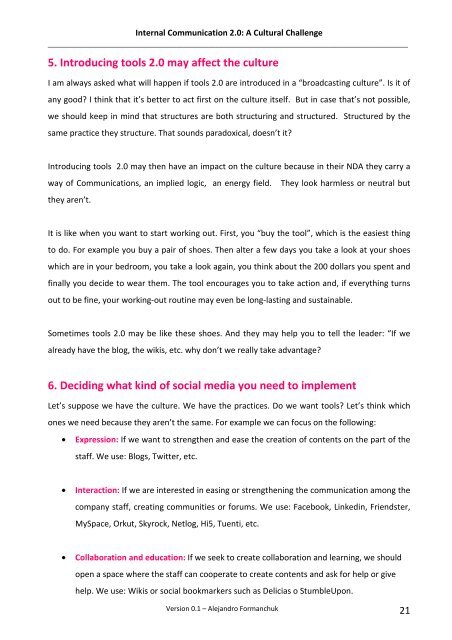Internal Communication 2.0 - Formanchuk & Asociados
Internal Communication 2.0 - Formanchuk & Asociados
Internal Communication 2.0 - Formanchuk & Asociados
Create successful ePaper yourself
Turn your PDF publications into a flip-book with our unique Google optimized e-Paper software.
<strong>Internal</strong> <strong>Communication</strong> <strong>2.0</strong>: A Cultural Challenge<br />
_______________________________________________________________________________<br />
5. Introducing tools <strong>2.0</strong> may affect the culture<br />
I am always asked what will happen if tools <strong>2.0</strong> are introduced in a “broadcasting culture”. Is it of<br />
any good? I think that it’s better to act first on the culture itself. But in case that’s not possible,<br />
we should keep in mind that structures are both structuring and structured. Structured by the<br />
same practice they structure. That sounds paradoxical, doesn’t it?<br />
Introducing tools <strong>2.0</strong> may then have an impact on the culture because in their NDA they carry a<br />
way of <strong>Communication</strong>s, an implied logic, an energy field. They look harmless or neutral but<br />
they aren’t.<br />
It is like when you want to start working out. First, you “buy the tool”, which is the easiest thing<br />
to do. For example you buy a pair of shoes. Then alter a few days you take a look at your shoes<br />
which are in your bedroom, you take a look again, you think about the 200 dollars you spent and<br />
finally you decide to wear them. The tool encourages you to take action and, if everything turns<br />
out to be fine, your working-out routine may even be long-lasting and sustainable.<br />
Sometimes tools <strong>2.0</strong> may be like these shoes. And they may help you to tell the leader: “If we<br />
already have the blog, the wikis, etc. why don’t we really take advantage?<br />
6. Deciding what kind of social media you need to implement<br />
Let’s suppose we have the culture. We have the practices. Do we want tools? Let’s think which<br />
ones we need because they aren’t the same. For example we can focus on the following:<br />
• Expression: If we want to strengthen and ease the creation of contents on the part of the<br />
staff. We use: Blogs, Twitter, etc.<br />
• Interaction: If we are interested in easing or strengthening the communication among the<br />
company staff, creating communities or forums. We use: Facebook, Linkedin, Friendster,<br />
MySpace, Orkut, Skyrock, Netlog, Hi5, Tuenti, etc.<br />
• Collaboration and education: If we seek to create collaboration and learning, we should<br />
open a space where the staff can cooperate to create contents and ask for help or give<br />
help. We use: Wikis or social bookmarkers such as Delicias o StumbleUpon.<br />
Version 0.1 – Alejandro <strong>Formanchuk</strong> 21












